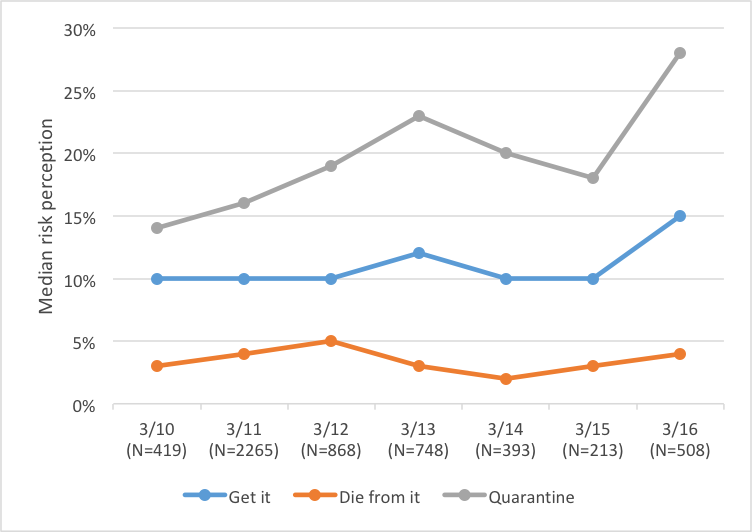According to a new USC study, people across the U.S. are stepping up their hand washing and social distancing, are perceiving increasing risks of getting sick, dying, and getting quarantined because of coronavirus, while suspected illness and symptoms seem to be stable.
From March 10 to 16, USC fielded a nationally-representative survey of public perceptions and responses to the novel coronavirus epidemic. The survey occurred during the week when President Trump declared a national emergency, but before many schools and businesses were closed. We released preliminary results on March 12. More findings and information about the methodology will be available here.
Since our survey was in the field for several days, a day-to-day comparison of perceptions and behaviors can provide a look at how people have reacted to so many rapid changes. Readers should interpret these findings with caution. Respondents were all invited to complete the survey on the same day, but some people responded more quickly than others. Respondents who completed the survey on different days could differ in important factors that might affect their responses. However, the patterns below hold if we control for age, gender, education, employment status and race/ethnicity.
Stepped-up Prevention Behaviors
Respondents were asked what they had done to keep themselves safe from the coronavirus over the past seven days, compared to what they normally do. In Figure 1, people generally stepped up preventative actions from March 10 to March 16.
- Stepping-up hand washing increased from 82 percent on March 10 to 94 percent on March 16.
- Social distancing rose from 57 percent on March 10 to 89 percent on March 16. Social distancing included canceling or postponing travel for work or for pleasure; canceling or postponing work or school activities, or personal or social activities; avoiding public spaces, gatherings, or crowds; avoiding contact with people who could be high risk; avoiding eating at restaurants; and working or studying at home.
- Praying rose from 47 percent on March 10 to 57 percent on March 16.
- Stockpiling food or water rose from 21 percent to 43 percent.
- Canceling a doctor’s appointment went up from 4 percent on March 10th to 19 percent on March 16.
- Wearing a face mask was the one action that remained mostly consistent, and was reported by 9 percent of respondents on March 10 and by 8 percent of respondents 12 percent on March 16.
Figure 1: Reported Actions Over Past Seven Days, by Survey Date

Increasing Risk Perceptions
Respondents’ perceptions of the health, economic, and quarantine risks of the coronavirus generally rose over the survey period. Figure 2 shows changes in perceptions over time.
- The median perceived risk of contracting COVID-19 within the next three months was 10 percent on March 10, but increased to 15 percent on March 16.
- The perceived risk of dying if infected with the coronavirus varied between 3-5 percent, but overall tended to increase somewhat over the course of most survey days.
- The median perceived risk of being quarantined within the next three months was 14 percent on March 10 but doubled to 28 percent on March 16.
- Most employed respondents saw a 0 percent chance of losing their job within the next three months, regardless of the day of the survey. However, the percent of respondents who perceived a high (25 percent or greater) risk of job loss rose from 12 percent on March 10 to 28 percent on March 16.
- Most respondents perceived little or no chance of running out of money within the next three months, regardless of the day of the survey. However, the percent of respondents who perceived a high (25 percent or greater) risk of running out of money rose from 13 percent on March 10 to 27 percent on March 16.
Figure 2: Risk Perceptions by Survey Date

Wändi Bruine de Bruin is Provost Professor of Public Policy, Psychology and Behavioral Science at the University of Southern California, with affiliations in the USC Schaeffer Center and the USC Dornsife College’s Center for Economic and Social Research, as well as the USC Price School for Public Policy and USC Dornsife College Department of Psychology. She aims to understand and inform how people make decisions about risk. Daniel Bennett is an economist at the USC Center for Economic and Social Research. He studies health behavior and decision making. Learn more about Dr. Bruine de Bruin’s research on her website. Learn more about Dr. Bennett’s research on his website.

You must be logged in to post a comment.